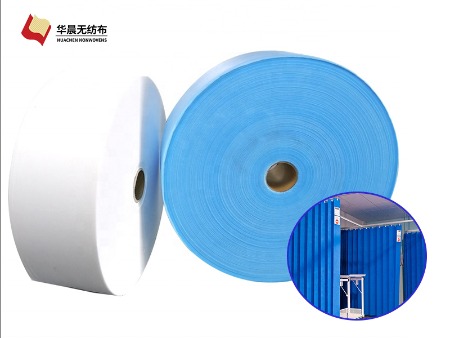Laminated nonwoven fabric is a composite material that is formed when spunbond or spunmelt nonwovens are bonded with low density polyethylene (LDPE) or high density polyethylene (HDPE) films. This process provides a waterproof layer that is environmentally friendly, impermeable to contaminants, breathable, lightweight, and suitable for printing.Laminated nonwoven fabric is often used in the diagnosis and treatment, environmental sanitation, safety protection, industrial production and automotive industry. It is a newly developed material that has many useful features.The delamination strength of a laminated nonwoven fabric is measured by tensile and compressive tests. Laminated nonwoven fabric has a high level of fluid protection, is waterproof and breathable.Various kinds of nonwoven fabrics are laminated together to obtain better strength, stability, sound insulation and appearance properties. These types of laminated nonwoven fabric are used for isolation gowns, surgical gowns, drapes & covers, scrub suits, food grain packaging and shopping bags.

For interleaved carbon fiber reinforced polymer (CFRP) laminates, the fracture toughness depends on both density and fiber length of NWCTs. When a high density and the length is longer than a predetermined value, the interlaminar fracture toughness increases significantly.Stitching may increase the CAI strength and fracture toughness of a laminated nonwoven fabric by increasing the interlaminar crack resistance. Laminated nonwoven fabric is a kind of fabric that does not use spinning and weaving. It orients or randomly arranges textile staple fibers and filaments to form a web structure, then uses mechanical, thermal bonding or chemical methods to reinforce it.
This type of fabric is widely used in various fields such as civil engineering and construction, agriculture, automobiles, clothing, cosmetics, and medicine. It is flexible and can be adapted to a variety of purposes by changing the raw material, manufacturing method, sheet thickness or density.The texture of laminated nonwoven fabrics is very good, which is a great advantage for the production of clothes. It has good elasticity and warmth, and can be printed in bright colors.The material of the laminated nonwoven fabric can be a melt-blown non-woven fabric or spun-bonded non-woven fabric of polyester-type fibers. It is a new type of composite non-woven fabric.A non-woven fabric laminate is a special type of fabric that is composed of a number of layers of different fabrics through bonding and lamination. It is used for a variety of purposes such as medical, health, protective, industrial and automotive industries.
For example, a non-woven fabric laminate can be provided with characteristics such as excellent stretchability, flexibility, moisture permeability, air permeability, a fuzzing resistant property, and strength. In addition, the non-woven fabric laminate can be provided with a locking property for a mechanical fastening female material as needed.In particular, a long fiber of a thermoplastic elastomer (A) and a long fiber of a thermoplastic resin composition (B) are cooled in a cooling chamber, stretched (towed) by a stretching air and accumulated on a moving collection face, and formed to form a mixed fiber spunbonded non-woven fabric (C1).The non-woven fabric laminate may be used for a part that is required to be flexible or a section that requires an excellent permeability of water, such as a sanitary napkin, a disposable medical gown, and a work cloth.
Laminated nonwoven fabric is a type of nonwoven that features a waterproof layer made up of low density polyethylene (LDPE) or high density polyethylene (HDPE) films, and a layer made up of spunbond nonwoven fabric. It is a highly versatile product that can be used for a variety of applications and offers properties such as barrier properties, hydrostatic pressure resistance, chemical resistance, heat resistance, and water absorption.The laminated nonwoven fabric of the present invention comprises an intermediate layer obtained by melt-blowing an olefin-type resin and an inner and outer layer derived from a spun-bonded non-woven fabric consisting chiefly of polyester fibers, which are laminated one upon another. The inner and outer layers are bonded together owing to the intermingled fibers.


